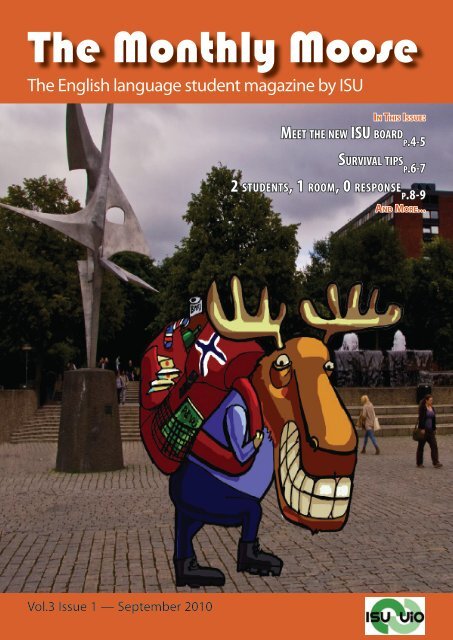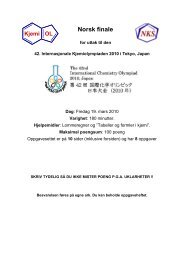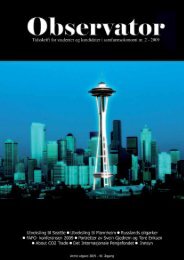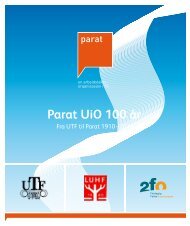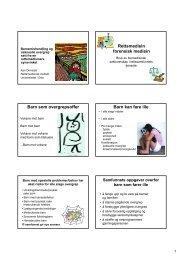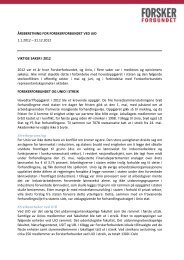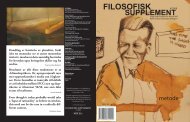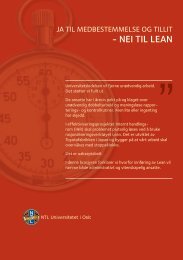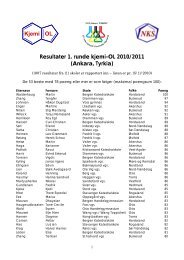The Monthly Moose - Norwegian website
The Monthly Moose - Norwegian website
The Monthly Moose - Norwegian website
You also want an ePaper? Increase the reach of your titles
YUMPU automatically turns print PDFs into web optimized ePapers that Google loves.
<strong>The</strong> <strong>Monthly</strong> <strong>Moose</strong><br />
<strong>The</strong> English language student magazine by ISU<br />
In Th i s Is s u e:<br />
Mee t th e ne w ISU b o a r d p.4-5<br />
Su r v i v a l t i p s p.6-7<br />
2 s t u d e n t s, 1 r o o m , 0 r e s p o n s e p.8-9<br />
An d Mo r e...<br />
Vol.3 Issue 1 — September 2010
Dear Readers,<br />
In the beginning there was a question.<br />
And the question was “Why Norway?”<br />
Somehow, you came up with a fitting<br />
answer for your application, and now<br />
you are here. Now that you have<br />
arrived, the question of “Why Norway?”<br />
has turned into “Why did you come to<br />
Norway?” Perhaps you’ve come up with<br />
a response. Or perhaps not. Maybe a<br />
new question has come to mind: “Why<br />
(the heck) did I choose Norway?” or<br />
more likely “Norway, WHY???”<br />
We know you are out there, being<br />
ripped off daily by Vinmonopolet and<br />
overpriced food chains, facing housing<br />
issues, feeling frustrated by your<br />
inability to speak <strong>Norwegian</strong>, and at<br />
times feeling lonely., and asking why.<br />
And well, we don’t have an answer.<br />
Furthermore, we are not going to find<br />
one for you (although we will try harder<br />
if you offer us enough money...) All<br />
we have to offer is a few dozen pages<br />
of text in English, written by students<br />
like you and for students like you in a<br />
language you can understand. We hope<br />
you enjoy it. We really hope that you<br />
enjoy all of your time in Norway, so that<br />
your final question leaving this country<br />
is “Why do I have to leave?”<br />
This is just the beginning of a long way.<br />
Walk with the <strong>Moose</strong> of Norway.<br />
Marija, the <strong>Moose</strong> Herder<br />
EDITORIAL<br />
Looking Back, Looking Forward:<br />
<strong>The</strong> <strong>Moose</strong> In <strong>The</strong> Year Ahead<br />
A few weeks ago, we stood on a stage, antlers raised<br />
(literally), and accepted an award recognizing us<br />
as the best student publication of the year. In the<br />
aftermath of the whirlwind of award ceremonies<br />
and opportunities to eat free food, we found<br />
ourselves wondering what exactly this meant.<br />
On the one hand, we are honored. Several of us<br />
on the editorial board this year have worked<br />
with the magazine last year, and it’s gratifying<br />
to bask in the limelight. On the other hand, the<br />
recognition comes at a time when hundreds of<br />
international students are unwilling subjects<br />
in SiO’s housing “experiment” at Kringsjå.<br />
We are not naive enough to be completely<br />
unaware of the implications of an ISU-related<br />
magazine winning an award at a time where the<br />
University of Oslo is actively pursuing a policy<br />
of internationalization, coupled with a housing<br />
shortage which seems to have left international<br />
students trapped between goals and reality.<br />
Regardless, what is apparent is that we cannot<br />
rest on our laurels. Much like the international<br />
student population at UiO, our staff is fluid.<br />
Many of the contributing writers, proofreaders,<br />
photographers and artists from last year are<br />
scattered across several continents, but this<br />
semester has already brought new staff, fresh<br />
ideas, and expanded horizons. In the past, we<br />
have primarily been seen as international student<br />
magazine only. This year, we hope to forge new<br />
relationships with <strong>Norwegian</strong> student media, and<br />
capitalize on our sudden exposure to help share<br />
the trials, tribulations, and joys of life in Oslo as<br />
experienced by both newcomers and <strong>Norwegian</strong>s<br />
alike. We hope you’ll be along for the ride!<br />
Th e Mo o s e editorial b o a r d<br />
2 \\ Editorial<br />
Th e Mo n t h l y Mo o s e — Villa Eika, Blindern 0314 Oslo, P.O. Box 1088. monthly.moose@gmail.com<br />
Ch ie f Ed i t o r: Marija Cabuskina — Wr i t e r s: Anita Iyer, Blayne Sapelli, Daniel Rolin, James Spinks,<br />
Anita Iyer — Pr o o f Readers: Anita Iyer, Heather Baker, James Spinks, Mitch Molstad, Sara Fegelman<br />
Marija Cabuskina, Sara Fegelman, Summer Choi — Co v e r Design: Marija Cabuskina, John Modin
CONTENTS<br />
6<br />
4 Meet Th e New ISU Bo a r d<br />
6 Su r v iv a l Ti p s<br />
8 Th e Ho u s i n g Sa g a<br />
10 Ho w d i d t h e Mo o s e w i n a SiO Aw a r d<br />
11 Sc a l i n g Gl a c i e r s<br />
14 Su m m e r a t By g d ø y<br />
16 Mo s t l y Har mless<br />
18 Bi r t h d a y s Ar o u n d t h e Wo r l d<br />
20<br />
20 Ca t s a n d Do g s<br />
22 I l o v e Oslo<br />
24 Br e a d a n d Ga m e s<br />
25 Fa m o u s No r w e g i a n s<br />
26 ELGINT 0110<br />
27 Best o f No r w a y<br />
28 Th e Mo o s e Fr i d g e Do o r<br />
22<br />
JeeHee Hwang, Josefien Breedvelt, Julie Rousseau, Marija Cabuskina, Paris Obdan — Co p y Ed i t o r:<br />
— Ph o t o Ed i t o r: Sara Fegelman — Vi s u a l Co n t e n t: Ana Rollán, John Modin, Julie Rousseau,<br />
— La y o u t: Julie Rousseau, Marija Cabuskina.<br />
Co n t e n t s // 3
V I C E<br />
Meet the new<br />
ISU PRESIDENT<br />
Full name: Lubica Rozborova<br />
From: Slovakia<br />
Why are you going to be the best<br />
damn President ever?<br />
I don’t promise, I just work.<br />
I don’t believe Slovakia is a real<br />
country. I think it’s some kind of<br />
elaborate practical joke to confuse<br />
Americans.<br />
Our country is so beautiful, and if you don’t know about it,<br />
that’s your problem.<br />
ISU (International Student<br />
Union) is ISU Oslo is a branch<br />
of ISU Norway, a non-profit<br />
organization run for and by<br />
international students. . ISU<br />
collaborates with the Student<br />
Parliament of UiO to represent<br />
international students.<br />
Elections were held at the<br />
International Coffee Hour<br />
on Friday, September 3rd<br />
ISU VICE-PRESIDENT<br />
SECRETARY<br />
4 \\ Who's the new ISU?<br />
Full name: Daniel Rolin<br />
From: Slovakia,<br />
Why are you going to<br />
make the best damn Vice<br />
President ever?<br />
I was the author of the<br />
Kringsja 24 petition, but<br />
the administration refused to meet with me<br />
even though we collected more than a hundred<br />
signatures. Now, I have a title, and that gives me<br />
leverage to make compensation happen. I’m<br />
good at negotiating. Basically, I’m going to<br />
be the best damn president ever’s right hand<br />
man!<br />
What kind of experience do you have?<br />
I’ve worked as an Amnesty International lobbyist.<br />
Hypothetically, if some kind of terrible scandal<br />
were to destroy your administration, what<br />
would it be?<br />
Utter negligence.<br />
Full name: Radan<br />
Furiel<br />
From:Slovakia<br />
Why are you<br />
going to<br />
make the best damn General<br />
Secretary of all time?<br />
I have no ambition to say I’m the<br />
best, that’s up to others to decide.<br />
Hypothetically, if some kind of<br />
terrible scandal were to destroy<br />
your administration, would it<br />
more likely involve prostitutes<br />
or cocaine?<br />
Definitely prostitutes.<br />
Two of th e board members (the Trip<br />
minister and the Webmaster) were<br />
unavailable for interview. Meet them in<br />
the new <strong>Moose</strong>!
ISU board!<br />
CHIEF EDITOR OF<br />
Join our Facebook<br />
group<br />
<strong>The</strong> International Students’<br />
Union at the University of<br />
Oslo 2010/2011<br />
Contact us by e-mail<br />
isu.oslo@gmail.com<br />
THE MONTHLY MOOSE<br />
Full name: Marija Cabuskina<br />
From: Latvia<br />
Why are you going to be the best damn<br />
Editor in Chief of the <strong>Monthly</strong> <strong>Moose</strong><br />
ever?<br />
Because we’re worth it! We’re the only<br />
media here on campus that publishes exclusively in English.<br />
We have to do our best to inform tnternational students here<br />
that don’t speak <strong>Norwegian</strong>.<br />
Is there any conflict of interest inherent in being<br />
interviewed by one of your own staff members?<br />
<strong>The</strong>re certainly is, but I’m also writing for the <strong>Moose</strong>, and it’s<br />
probably better than interviewing myself.<br />
SOCIAL AFFAIRS<br />
MINISTER<br />
Full name: Alizamin<br />
Jafarli,<br />
From: Azerbaijan<br />
Why are you going to<br />
make the best damn<br />
Social Affairs Minister<br />
ever?<br />
I want to get all students socialized in<br />
addition to their studies, because it’s<br />
important for everyone to have a better<br />
understanding of the world, and the best<br />
way to do that is by meeting other people.<br />
Considering your lack of Borat, why is<br />
Azerbaijan better than Kazakhstan?<br />
First of all, why did you ask that question?<br />
Why Kazakhstan as opposed to any other<br />
country in Asia?<br />
ACADEMIC AND PO-<br />
LITICAL AFFAIRS<br />
Full name: Jared Lennon<br />
From: USA<br />
Why are you going to be<br />
the best damn Political<br />
Affairs Minister ever?<br />
I’ve studied political<br />
science for years, I have<br />
an avid interest in politics of all kinds, and I’m<br />
going to do my very best to fight for the needs<br />
of international students.<br />
What kind of experience do you have?<br />
I’ve worked for a US Senator dealing with<br />
constituents.<br />
Hypothetically, if some kind of<br />
terrible scandal were to destroy your<br />
administration, what would it be?<br />
Money laundering with the <strong>Norwegian</strong> Mafia.<br />
Text:Blayne Sapelli<br />
Photos: John Modin<br />
Who's the new ISU? // 5
Free Adv i c e:<br />
11 Tips To Getting <strong>The</strong> Most Out Of Life In Oslo<br />
A<br />
new semester, a new country, a new city– adjusting to life in Oslo can be tough and expensive,<br />
especially for for those new to Norway. Here are some quick tips to help you stay safe, save money,<br />
and get the most out of life in Oslo<br />
1) Free food at Kiwi: By now, most of you are probably aware that Kiwi is one of the cheapest<br />
places to buy groceries. But did you know that you can get food there for free? Kiwi guarantees that all<br />
the food sold in their shops is fresh, and backs this promise up with a sweet deal – if you find anything<br />
which expires today or tomorrow on the shelves, you get the product for free. Expired products<br />
can be traded for a fresh version of the same product, and expired cigarettes or alcohol net you the<br />
equivalent value in cash. So start checking those expiration dates!<br />
2) Loppemarkeds: Secondhand shopping in the fresh air is a great way to find cheap furniture,<br />
clothes, books, music, or whatever else you need but don’t necessarily want to buy brand-new. So<br />
grab some cash and check out the weekly Saturday market under the bridge at Grønland (right next<br />
to the T-bane station) or hit the Sunday market at Birkelunden.<br />
3) Grønland for Greens: In need of fresh fruits and veggies? <strong>The</strong>n hop the T-bane to Grønland!<br />
<strong>The</strong> small immigrant-run shops routinely rank at the top of the list of places to find the best and<br />
cheapest produce. This area is also home to the source of some of the cheapest kebabs in the city.<br />
4) Medical Assistance, 24/7: Need to see a doctor? <strong>The</strong> 24 hour legevakt (emergency clinic)<br />
at Storgata 44 is always open. You’ll also find a 24 hour pharmacy there.<br />
6 \\ Su r v i v a l Ti p s
Text by Anita Iyer<br />
Photo by Summer Choi<br />
5) Late T-Bane? Take a cab!: If you are waiting for a bus, T-bane, boat or tram in Oslo which<br />
is running more than 20 minutes late, Ruter will cover the cost of a cab up to 500 kr to get you to your<br />
location. Read more about the guarantee here www.sporveien.no/PageFiles/227/travel_guarantee_<br />
feb2010.pdf.<br />
6) Shopping on Sundays: <strong>The</strong>re’s nothing that makes a Sunday morning hangover worse<br />
than awaking and realizing that you are completely out of food/toilet paper/coffee. Luckily, there are<br />
several smaller grocery stores open on Sundays, such as the Joker, Bunnpris, and Ica at Majorstuen, as<br />
well as many of the shops in Grønland.<br />
7) <strong>The</strong> Night Bus: Before your next night on the town, familiarize yourself with the night bus<br />
schedule. <strong>The</strong> cost of the night bus is covered under a valid monthly student transit card. If you don’t<br />
have a student transit card, the night bus is still cheaper than taking a taxi home. Check out www.<br />
trafikanten.no for more info.<br />
8) Cheap(er) Haircuts: Like much else in Oslo, haircuts here are quite expensive. Those of<br />
you in need of a new and unwilling to trust the scissors to a friend (or go the do-it-yourself route) can<br />
always hit one of the styling schools in Oslo. Here, students will style your hair under the watchful<br />
gaze of seasoned professionals who will intervene if necessary. Some places to check out include the<br />
Auster Academy on Karl Johan, or Adam and Eva, located near Jernbanetorget.<br />
9) Free Entertainment: It might feel like everything in Oslo costs a lot of money, but things<br />
do happen in this city for free. <strong>The</strong> <strong>website</strong> Oslo Pulse (www.oslopuls.no) offers a searchable calendar<br />
of events. Unfortunately, it’s in <strong>Norwegian</strong>, but with the aid of a dictionary, a translation tool, or a<br />
<strong>Norwegian</strong> friend, even the least skilled in <strong>Norwegian</strong> can navigate it. Remember, the word for free is<br />
gratis!<br />
10) Embrace Friluftslivet!: Life in Norway is all about embracing friluftsliv, or literally the<br />
fresh air life. Living in Oslo means that an excellent selection of swimming, hiking, and in a few months<br />
time, skiing opportunities are just a short bus or T-bane ride away. Check out DNT’s (Den Norske<br />
Turistforening) <strong>website</strong> for more information. http://www.turistforeningen.no/<br />
11) Emergency: Hopefully, you’ll never need this information, but in case of an emergency,<br />
dial:<br />
110 - Fire<br />
112 – Police<br />
113 - Ambulance<br />
120 – Emergency at open sea<br />
Su r v i v a l Ti p s // 7
<strong>The</strong> Hou<br />
8 \\ 2 students, 1 room, 0 reply<br />
<strong>The</strong> Vice President of ISU UiO<br />
summarizes the inconveniences<br />
and frustrations felt by<br />
hundreds of international<br />
students living at Kringsjå.<br />
Each year, the University of Oslo welcomes<br />
hundreds of new foreign students. Many<br />
of these are onesemester<br />
exchange<br />
students from other<br />
universities all over<br />
the world. However,<br />
the routine of happy<br />
exploration of the<br />
beauties of Oslo had<br />
a rather bitter taste<br />
for many of these<br />
exchange students.<br />
<strong>The</strong> reason was their<br />
a c c o m m o d a t i o n .<br />
This year, SiO came<br />
up with a new idea<br />
for increasing their<br />
a c c o m m o d a t i o n<br />
capacities. <strong>The</strong>y call this trial project “two-ina-room”.<br />
One-semester exchange students<br />
were offered the opportunity to share their<br />
rooms with a fellow student. <strong>The</strong> information<br />
given promoted the concept as a great<br />
way to save money, and promised great<br />
conditions for a seemingly fair price.<br />
Many of the students liked the offer,<br />
and signed up. In the end, however,<br />
even those that still requested a single<br />
room, valuing privacy above money,<br />
ended up sharing their living space<br />
with strangers they had never seen<br />
before. According to a letter from SiO,<br />
the housing<br />
situation did<br />
not permit any<br />
other solution.<br />
And that is<br />
how over 200<br />
students began<br />
their semester<br />
in Oslo living in<br />
the “Exchange<br />
student ghetto”,<br />
better known<br />
as Kringsjå<br />
b u i l d i n g s<br />
24 and 26.<br />
U p o n<br />
arrival, the<br />
disappointment of the students was<br />
huge. In a little room of about 10 square<br />
meters they only found one internet<br />
socket that they have to share, taking<br />
turns to prepare for school or Skype<br />
with their families. <strong>The</strong> one table in the
sing<br />
“Solution”<br />
room is big enough to fit<br />
in two laptop computers, but<br />
not enough to fit textbooks and<br />
compendia next to them. <strong>The</strong> single<br />
chair, single bed stand, single wardrobe<br />
and single shelf left these students<br />
with no doubts that the two-in-a-room<br />
concept is nothing more than a former<br />
single room with one extra bed.<br />
<strong>The</strong> erratic furnishing of the rooms<br />
was underpinned by the state of<br />
the so-called study room. With two<br />
kindergarten tables, no chairs, and of<br />
course no internet, these rooms are<br />
absolutely unusable (except as space<br />
for drying clothes). This all for 2300 NOK<br />
per person (4600 per room). Compared<br />
to the rent for a single room at Kringsjå,<br />
which ranges from 2600 to 3300 NOK,<br />
this is definitely not a good deal.<br />
Well, never mind, at least they can<br />
still experience <strong>Norwegian</strong> culture and<br />
learn the language. Or can they? Since<br />
the “two-in-a-room” novelty is being<br />
tested on foreign students only, there<br />
is not a single <strong>Norwegian</strong> living in any<br />
of the two buildings. In effect, they<br />
came to Oslo to experience German,<br />
Polish, Korean and Spanish culture. This<br />
isn’t exactly what they had planned.<br />
Disappointment changed into action.<br />
Both buildings drafted petitions addressed<br />
to SiO, demanding a fix to the problems<br />
and lower rent. But these students met with<br />
yet another disappointment. Although the<br />
petitions were signed by over 130 students,<br />
it took over two weeks to get a reply. In their<br />
letter, SiO customer service provided only<br />
vague and unspecific promises, and tried to<br />
justify the price by “having more common<br />
space” (remember the study room?).<br />
Most of the affected students agree that the<br />
housing problem is seriously complicating<br />
their lives. Feelings of being cheated and<br />
treated unfairly are very common, and<br />
the belief in <strong>Norwegian</strong> efficiency and<br />
good organization is long-gone. Today, the<br />
students are not alone, as the International<br />
Students Union at UiO is trying to push the<br />
SiO administration to fix the deficiencies<br />
and provide fair compensation. We<br />
know, however, that these students<br />
will probably forever connect the words<br />
“semester in Oslo” to “bad experience”.<br />
Daniel Rolin<br />
2 students, 1 room, 0 reply // 9
Answers to Pressing Questions<br />
Interview by Anita Iyer<br />
A few weeks ago, <strong>The</strong> <strong>Monthly</strong> <strong>Moose</strong> was recognized as the Årets Publikasjon (Publication of the year)<br />
for the 2009/2010 school year. While we were honored by this recognition, we realized that we didn’t<br />
have a clear idea about how this came about. Luckily, the <strong>Moose</strong> was able to pick the brain of the<br />
Studentsamskipnaden i Oslo’s (SiO) Rolf Andersen for information on the award, the nomination<br />
process, and his motivation for nominating an English language student magazine for recognition.<br />
<strong>The</strong> <strong>Moose</strong>: Since its inception, <strong>The</strong> <strong>Monthly</strong><br />
<strong>Moose</strong> has been a magazine aimed largely at the<br />
international student community. Obviously, you<br />
don’t fit this mold. How did you come to know<br />
about the <strong>Moose</strong>?<br />
Rolf Andersen: About two years ago I walked<br />
by a stack of <strong>The</strong> <strong>Monthly</strong> <strong>Moose</strong>s (Meese?) in<br />
Frederikke, and I’ve been hooked ever since. I’m<br />
always on thelookout for a new issue!<br />
Current chief editor Marija Cabuskina, contributor Josefien Breedveit,<br />
former chief editor Julie Rousseau and copy editor Anita Iyer all<br />
antlered up at the SiO award ceremony. Not present is photo editor<br />
Sara Fegelman. Photo by Mike Fürstenberg.<br />
M: Can you tell us a little about what you do with SiO?<br />
R.A.: Until recently, I was the head of SiO Studentliv, which provides training, economic support and<br />
other assistance to student organizations and activities. Since this summer I’ve been working in SiOs<br />
Student Housing Division, where among other things I coordinate the Resident Assistant program.<br />
M: We naturally think that we are a fabulous magazine, but we were surprised at the support we<br />
received [from the awards committee]. Can you tell us why you felt <strong>The</strong> <strong>Monthly</strong> <strong>Moose</strong> deserved the<br />
title of Best Publication?<br />
R.A.: What makes the <strong>Moose</strong> a winner is a combination of several factors. <strong>The</strong> contents and the layout<br />
are of a reasonably high quality, and it is a big plus that the magazine is constantly striving to be<br />
better. <strong>The</strong> frequency and stability in the rate of publication is impressive, and in itself an important<br />
reason why the <strong>Moose</strong> has become a community builder among international students at UiO. Finally,<br />
I’d like to mention the varied content, use of many contributors and your function in describing and<br />
explaining UiO and Norway to international students.<br />
10 \\ Wi n n e r: Th e Mo n t h l y Mo o s e<br />
M: We are a little unsure about how the nomination process works. Can anyone submit a nomination,<br />
or is this a right reserved for faculty and staff?<br />
R.A.: <strong>The</strong> award is given annually by UiO and SiO, and covers activity in the previous academic year.<br />
<strong>The</strong>re are four categories: Student Organization of the Year, Student Publication of the Year, Best<br />
Single Event of the Year and Newcomer of the Year. Any student or group of students at UiO, as well<br />
as the faculty and UiO and SiO staff may nominate candidates. A jury selects three finalists in each<br />
of the categories, and then decides which of these is the winner. You’ll find details about next year’s<br />
nomination process on SiO Studentliv’s and UiO’s <strong>website</strong>s in late April or early May. <strong>The</strong>y also have<br />
information about previous winners and nominees.<br />
M: Is there anything else you’d like to share with us?<br />
R.A.: Congratulations! Keep up the good work! One of the things I hoped to accomplish by nominating<br />
<strong>The</strong> <strong>Monthly</strong> <strong>Moose</strong> for Student Publication of the Year, is to make the magazine better known,<br />
improving distribution and getting more <strong>Norwegian</strong> students to read it. You could play an important<br />
role in increasing contact between <strong>Norwegian</strong> and international students. I hope this will happen.<br />
You certainly deserve it.
A Weekend Trip<br />
to the Fjords,<br />
Fjaerland<br />
and the Nigard Glacier.<br />
In the weekend from 3 to 5 September, 14 other international students and I<br />
went to see the fjords, Fjearland and our final destination, the Nigard Glacier.<br />
Fjaerland is an area that surrounds a branch of the Sogn Fjord. <strong>The</strong> Sogn Fjord is close to the Jostedal<br />
Glacier. This is the largest glacier in mainland Europe, and it is 487 km long in total and at some points<br />
it is almost 600 meters thick. <strong>The</strong> Jostedal Glacier has about 22 glacier arms or glacier tongues, some<br />
of them go totally down to the valley, and we got the opportunity to climb one.<br />
As a person coming from Holland, where most of the land is extremely flat. I was amazed to see such<br />
huge mountains, and I was impressed by the greatness of the <strong>Norwegian</strong> nature on the trip.<br />
This trip was organized by a small company named Hiking in Norway, they provided us with professional<br />
guidance during the whole<br />
trip. We got to lend some<br />
hiking stuff and with a lot<br />
of experience, they gave us<br />
the best care on the whole<br />
trip.<br />
Day 1<br />
We had to gather at nine<br />
o’clock at Blindern. We<br />
stuffed our bags in the<br />
car and were on our way<br />
to our cabins. We took<br />
the historical route and<br />
stopped at some important<br />
historical sites of Norway.<br />
First, we crossed the<br />
border between eastern<br />
and western Norway. <strong>The</strong>n, we stopped at the Borgund Stave Church, which was completed in the<br />
12th century. This is the best preserved of the 28 existing stave churches in Norway. It is an amazing<br />
building. It is small, made of wood, of which many pieces are carved. It shows a part of the religious<br />
history of Norway. Still ,I wondered how they could fit a whole village in such a tiny church.<br />
We got some cheese on a small goat farm next to the road, and 5 minutes later we found the whole<br />
goat population in the middle of the road! This was worth stopping for! <strong>The</strong> cheese was very different<br />
from the sort found in a supermarket. It was brown and had a strong taste. I am not sure if everybody<br />
liked it!<br />
Afterwards we took a ferry to cross Sognfjord. <strong>The</strong> view was great. Imagine super clear, blue water<br />
and huge mountains. This was just the beginning of the trip and it was already amazing!<br />
We also got the opportunity to relax for one hour in a village called Sogndal; we bought some extra<br />
Glacier travelogue // 11
A Weekend Trip<br />
food (and drinks!) and loafed<br />
around in this small town.<br />
Before going to our huts we<br />
made a last stop at a glacier<br />
arm to get a true glaciology<br />
lesson. Because, what is actually<br />
considered a glacier? A glacier<br />
is actually a very thick ice layer<br />
which forms itself through<br />
compressed snow. <strong>The</strong> Nigard<br />
Glacier is actually not formed by extremely low temperatures, but by the high amount of snow that<br />
falls in the area. A glacier gets its blue color when it becomes very dense. After years of compression,<br />
the tiny air pockets between the crystals are forced out. <strong>The</strong> dense ice absorbs all other colors in the<br />
spectrum and reflects primarily blue. When you see white glacier ice, this means that there are still<br />
a lot of air bubbles in the ice. And, did you know that glaciers store about 75% of the world’s fresh<br />
water?<br />
<strong>The</strong> 7 hours drive was made more bearable because of the warmth and welcoming sphere of the<br />
other Erasmus students and the nice guides. With some music, some sleep and some talk, it was a<br />
great drive! After arriving, we had some delicious home-made lasagna and watched TV or played<br />
some games.<br />
Day 2<br />
12 \\ Glacier travelogue<br />
On the second day, after preparing a huge matpakke (lunch packet), we first went to the glacier<br />
museum. When entering this space-like building, we saw a movie and walked around the museum. <strong>The</strong><br />
museum was very interactive,<br />
so you could really learn about<br />
the glacier in practice.<br />
<strong>The</strong>n we drove to the booktown<br />
in Fjærland. <strong>The</strong>y have<br />
more books than people and<br />
sell them at a reasonably low<br />
price. It is worth it to see all the<br />
lovely houses filled up with a lot<br />
of books.<br />
Afterwards , we hiked to the<br />
Flatbre Glacier; this is a glacier<br />
arm found 1000 meters above
to the Fjords,<br />
Fjaerland<br />
and the Nigard Glacier.<br />
sea level. On the way up, we<br />
made a lot of stops since there<br />
were a lot of blueberries. It felt<br />
quite adventurous to climb on<br />
rocks and to walk across rivers.<br />
When we reached the glacier<br />
arm, we saw a big piece falling<br />
down; it was approximately 50<br />
meters in height. Our guide<br />
said she has never seen such<br />
an amount of glacier falling<br />
down. After four hours, we<br />
reached our final destination,<br />
the Flatbrehytta, a small hut where hikers meet. <strong>The</strong>n we went down again. Afterwards, we did<br />
some stretching. Since one of our guides is also a yoga teacher, we felt extremely Zen and content<br />
afterwards. It didn’t take long to find our beds after dinner that evening.<br />
Day 3<br />
On Sunday we got up early to clean our hut, pack our bags and go to the Nigard Glacier (Nigardsbreen),<br />
which is a glacier arm of the Jostedal Glacier. After arriving at the glacier arm, the first thing I noticed<br />
was the cold breeze coming in from the glacier. We went by boat across the lake underneath the<br />
Nigardsbreen, where we put on our crampons. <strong>The</strong>se are spiky things which fit underneath your<br />
shoes and help you to get more grip on the ice. For extra security we also were attached to a rope.<br />
<strong>The</strong> walk took 1.5 hours up, since on the glacier we kept to a very slow pace. It was quite hot on the<br />
glacier, and the reflected light worked as a big oven. Afterwards, we had the opportunity to cool<br />
down and have a swim in the glacier lake, which was 1 degree above Celsius. A few of us took the<br />
chance, and I experienced one of the coldest moments in my life.<br />
Overall, it was one of the most beautiful places I have been to in my life. <strong>The</strong> nature was amazing, the<br />
people were great, and we were very lucky with the weather! We were also in good hands with our<br />
guides, they helped us out a lot and made this weekend a truly memorable experience!<br />
Do you want to know more about hiking in Norway?<br />
Check the special events page at www.uio.no<br />
Text and photos: Josefien Breedveit<br />
Glacier travelogue // 13
Enjoy the last bits of Summer<br />
Bygdøy<br />
Photo by Summer Choi
Norway:<br />
mostly harmless<br />
16 \\ Norway: mostly harmless<br />
<strong>The</strong> reader should be aware that<br />
the following text contains copious<br />
references to the work of Douglas<br />
Adams. many omissions, and<br />
has much which is apocryphal,<br />
or at least wildly inaccurate.<br />
Far out in the uncharted backwaters of the unfashionable<br />
end of the galaxy lies a small, unregarded yellow sun.<br />
Around that sun ,several planets go about turning, of<br />
which only one, called unpretentiously the Earth by its<br />
inhabitants can boast of having life on it. Life though<br />
is a very dubious achievement , since it tends to lead<br />
to the destruction of itself and the planet it is on.<br />
This planet is arbitrarily divided into countries by<br />
species called humans, who consider themselves<br />
entitled to do so because of their relatively large<br />
brain. In this article we will touch upon Norway, one<br />
of such “countries” – not that it deserves a mention<br />
(except, of course, for the ragged coastline or “fjords”<br />
that has earned its creator a rather prestigious<br />
design award), but according to the rule of thumb<br />
for every guide book, 70% should contain useless<br />
information about places you don’t want to go.<br />
Norway is inhabited by <strong>Norwegian</strong>s (which is to say,<br />
largely uninhabited by them), who are not green and<br />
made of metal, as one of the early accounts of the<br />
planet suggested, written by a crew of humanologists<br />
who accidentally landed in a certain sculpture park in<br />
the capital, Oslo, on a Saturday morning. <strong>The</strong> account<br />
contains an interesting insight into the life, death<br />
and mating rituals of what was considered to be<br />
<strong>Norwegian</strong>s and theories of how Stone People evolved<br />
into Metal people. This has now been disproved, but<br />
due to bureaucratic reasons the news has not<br />
reached the department for the Studies of<br />
Uninteresting Peoples, which still produces<br />
papers on the link between square patches<br />
of burnt grass and the metal population.<br />
In contrast to this outdated report, <strong>Norwegian</strong>s<br />
are carbon-based, fairly intelligent, lifeforms<br />
slightly lacking in melanin compared<br />
to other humans. Space travelers should<br />
have no difficulty parking their transport<br />
in Norway, since <strong>Norwegian</strong>s are tolerant<br />
of weird-looking constructions. One of the<br />
visiting spacecrafts had the imprudence to<br />
land behind the National Gallery, and was<br />
subsequently seized by the municipality and<br />
converted to an exhibition hall. Most of the<br />
spacecrafts remain unnoticed though, because<br />
observation is not common among humans.<br />
Be careful not to venture out on a stroll if<br />
you don’t appear humanoid, lest you become<br />
subjected to tedious interplanetary legal<br />
proceedings. A court case brought by one<br />
gentleman from Alpha Centauri against a<br />
certain Edvard Munch of Earth after the latter<br />
had painted the portrait of the former, thus<br />
insulting him outrageously, ended with defeat<br />
of the plaintiff. <strong>The</strong> bone of contention, called<br />
“<strong>The</strong> Scream”, had to be appropriated from<br />
Earth several times to serve as evidence in <strong>The</strong><br />
Intergalactic Court of Humanoid Rights, after<br />
which the Earthman was found not guilty since<br />
only one of Centaurian’s heads was depicted.<br />
Among the recreational possibilities of Norway<br />
, drinking has to be avoided at all costs. To get<br />
an idea about alcohol prices in Norway, imagine<br />
you have enough money to feed a family of four<br />
for a month, including an overweight motherin-law<br />
that eats as much as one of the smaller<br />
Greater Dragons of Fiornan and a teenager. That<br />
amount of money would hardly be enough
to get you wasted<br />
in a bar, but could<br />
possibly buy you a<br />
few drinks. Conversely,<br />
you could try joining<br />
one of the anti-alcohol<br />
organizations where<br />
people boast about how<br />
many drinks they have<br />
resisted and how spectacular<br />
their hangovers might have been.<br />
Another type of legitimate fun you can have<br />
is spoiling <strong>Norwegian</strong>s’ hikes. <strong>Norwegian</strong>s<br />
evaluate the quality of their hikes by the<br />
number of people they have met along the<br />
way. Your appearance in one of those desolate<br />
regions of Norway can thus ruin a dream of<br />
any wannabe trailblazer: smile and wave and<br />
look genuinely happy. Picking up <strong>Norwegian</strong><br />
women is not an advisable leisure activity,<br />
since this presents no difficulty at all as long<br />
as you have the right amount of extremities.<br />
You can also try crashing business exhibitions<br />
and conferences. Apart from free food, you can<br />
also get to irritate top managers by asking about<br />
wages of their employees. Giving each other<br />
big sums of money, paying huge taxes and<br />
implementing energy-saving directives are just<br />
some of the hobbies of the elite. If you want to<br />
enjoy the wages, you should know that getting<br />
a job in Norway is easy. All you have to do is<br />
to know many <strong>Norwegian</strong>s. That is to say,<br />
getting a job in Norway is insanely difficult<br />
since <strong>Norwegian</strong>s are not people that<br />
immediately wish to be known by anyone.<br />
Not many <strong>Norwegian</strong>s know that their law<br />
codex was expanded and elaborated from a<br />
single sentence in a <strong>Norwegian</strong> childrens’ book<br />
which runs as follows: “You shall not disturb<br />
each other, you<br />
shall be nice and<br />
kind, otherwise<br />
you can do as you<br />
please.” <strong>The</strong>re is no<br />
official religion in<br />
Norway; however, most people believe<br />
that everything will sort itself out in<br />
the end, especially if you are nice enough.<br />
<strong>Norwegian</strong>s take pride in their language variety,<br />
which is not as prominent as on Astra-L 1 , but does<br />
comprise three official written languages, one of<br />
which is reserved for the shrinking indigenous<br />
population. Among the other two, only one is<br />
commonly used and the other is on life support in<br />
order to make pupils’ life less tolerable. <strong>The</strong> three<br />
written languages and the innumerable dialects are<br />
not the only reason for pride. <strong>Norwegian</strong>s also brag<br />
about their ability to stand on two planks of wood,<br />
positioned on an inclined surface, covered with frozen<br />
water – and their milk chocolate. Now chocolate is a<br />
widely known substance in our galaxy, forbidden<br />
in some star systems, available with prescription in<br />
others, but nowhere is the chocolate represented by<br />
a gooey milky variety. It has been speculated that to<br />
keep the factories alive (despite their failure to create<br />
something edible) the children of Norway had to go<br />
through aversion therapy to anything else except<br />
milk chocolate. Still, some small amounts of dark<br />
chocolate are produced for the immigrants, in the<br />
name of democracy and for dealing out in prisons.<br />
Norway is so damp and cold that you almost want to<br />
put it on your forehead when you have a temperature,<br />
if it weren’t so rocky. However, before you write<br />
Norway off complerely, you should note that the<br />
Encyclopedia Galactica ranks Norway as the one<br />
million and fifth worst place in the known universe.<br />
Marija Cabuskina<br />
Norway: mostly harmless // 17
Birthdays Around the World<br />
JeeHee Hwang<br />
Is your birthday on the way? Do you know what you should be doing on your birthday<br />
in Oslo? Well, there are many ways of celebrating birthdays from all around the world,<br />
so you don’t need to worry about it if you don’t have an idea of what to do. All you need<br />
is some tips. Here are eight students from eight different countries who told us about<br />
their birthday celebrations. So get ready for some new celebration tips!<br />
18 \\ Gratulerer m e d d a g e n!<br />
Brenna Wallach / USA<br />
“We don’t have a ‘traditional’ way of celebrating<br />
birthdays, but we light candles on a cake, sing<br />
birthday songs and then open presents. If I would<br />
have to find a tradition, it would have to be a<br />
family one. When my mother makes our birthday<br />
cakes, she puts money in the cake. This was also<br />
popular between my friends. <strong>The</strong>y used call it<br />
‘money cake’”.<br />
Aline Bussiere / France<br />
“We are pretty much the same as the other<br />
countries. We have a big meal with family, and<br />
eat a cake with candles on it. After spending time<br />
with family, we usually hang out with friends. We<br />
like to throw surprise parties. <strong>The</strong> 18 th birthday is<br />
very important in France.”<br />
Mai Yano / Japan<br />
“In Japan, we also like to throw surprise parties<br />
with friends, and parents give something special<br />
to their kids. It is good to give something round,<br />
by which I mean circle-shaped things, like a ball.<br />
Circular things have good meanings. On the 20 th<br />
birthday, we have a really big celebration. <strong>The</strong>re<br />
are ceremonies for those who turn 20, and we<br />
wear Japanese traditional clothes, such as the<br />
kimono. “<br />
Konstantin Oskotski / Russia<br />
“I would like to tell you more about birthday<br />
celebrations in Russia, but they are actually quite<br />
the same as in the rest of Europe. So there is always<br />
a cake with candles and food. In my family, we<br />
mostly had braised chicken with mushrooms and<br />
boiled potatoes as side dishes, then one of the<br />
favorite salads, Olivier (Russian Salad) or Dressed<br />
Herring, and a honey cake with a cream made of<br />
smetana (a type of Russian sour cream). We also<br />
had sweet yeast bread, which was widespread in<br />
ancient Russia to celebrate name days (and later<br />
birthdays) and today is mostly used at weddings.<br />
<strong>The</strong>re were also special dances and songs that<br />
people used to sing on such occasions. But today,<br />
hardly anyone still celebrates this way.”<br />
Eunson Choi / South Korea<br />
We celebrate birthdays by eating miyokguk<br />
(seaweed soup) in the morning. It is a kind of<br />
Korean tradition. After giving birth, or while<br />
pregnant, Korean women usually eat seaweed<br />
soup because it contains many nutrients that<br />
are good for pregnancies. <strong>The</strong>refore, seaweed<br />
soup is a symbol of birthdays in Korea.<br />
We even say ‘No luck for one year, without<br />
miyokguk on the birthday!’ In the afternoon or<br />
evening, we usually enjoy parties with friends,<br />
and blow candles out before eating cakes.
Hilde Arnestad Nilsen / Norway<br />
“<strong>Norwegian</strong> birthdays are celebrated with<br />
<strong>Norwegian</strong> food like pizza, hot dogs (pølse I brød)<br />
or other foods that the birthday kid wants to eat.<br />
<strong>The</strong>y also have a birthday cake and ice cream.<br />
Children can rent a place to have their birthday<br />
like McDonalds, bowling places or can just have<br />
it at home. <strong>The</strong>y also have party games such as<br />
Go Fish, a game where children will go fishing<br />
while an adult is behind a curtain, ready to give<br />
them bags of candy. Teenagers rent places like<br />
a teenage disco hall or a bowling alley. Adults<br />
might celebrate their birthday at home with<br />
friends and drinks, and later go downtown to go<br />
clubbing. But some might not want to celebrate<br />
their birthdays. All in all we love to party.”<br />
Joanna Kapala / Poland<br />
“It’s really nice that I can tell you about celebrating<br />
a birthday in Poland. Of course, the main way of<br />
celebrating a birthday is eating birthday cake.<br />
While you are blowing out the candles, you must<br />
think about some dream and not speak it aloud.<br />
Otherwise, this dream won’t come true. <strong>The</strong>re<br />
is no special food which we eat on birthdays.<br />
Usually, when somebody has a birthday, one<br />
eats what he/she likes the most, so it depends on<br />
one’s own likes. We put emphasis on celebrating<br />
the 18 th birthday. <strong>The</strong>n, we organize a big party<br />
for friends and family. Of course, the celebration<br />
depends on the family’s wealth. If they don’t have<br />
enough money to organize a party in a restaurant<br />
or pub, they have a barbecue, or invite guests to<br />
their house. That’s all about birthdays in Poland.<br />
It’s not very much, but it’s still something!”<br />
Hou Yuting / China<br />
“It’s mainly the same in China [as it is in other<br />
countries]. We eat cakes and have candles. A<br />
birthday party is a time for you to meet friends.<br />
We give gifts and go somewhere to have dinner,<br />
or in search of entertainment, such as KTV<br />
(Chinese name for karaoke), for example. We<br />
Chinese people eat noodles, which signify long<br />
life. We share noodles with others, and the more<br />
you share the noodles with others, the longer life<br />
you will have.”<br />
Maybe it is not so difficult to enjoy a global birthday party. Since we know that all of us<br />
enjoy birthdays, all we really need is a cake with candles, and of course, lovely friends!<br />
Gratulerer m e d d a g e n! // 19
Cats & Dogs<br />
20 \\ Surviving rain in Oslo<br />
I’m from Australia. Over there<br />
we have summers where the sun comes out for<br />
longer than two and a half hours at a time and<br />
winters which don’t freeze your jaw into place and<br />
shrink your penis (if you have one) to the size of a<br />
depleted party balloon. When I tell people where<br />
I’m from, I get variations of the same sentence:<br />
‘Really? Why would you come here? You must hate<br />
the weather!’ I usually look up optimistically at the<br />
dark grey sky and reply, ‘Nah, c’mon, it’s not that<br />
bad.’ But then it’s hard to sound convincing when<br />
your socks and shoes are soaking wet from stepping<br />
in puddles all day and<br />
a gust of freezing cold<br />
wind has just blown up<br />
the back of your t-shirt<br />
so abruptly that you’ve<br />
peed a little bit and now<br />
it’s starting to show<br />
through your jeans.<br />
Although I may not<br />
sound convincing, I am<br />
being honest when I<br />
say that it really isn’t<br />
that bad. Besides, who<br />
am I to complain about<br />
<strong>Norwegian</strong> weather?<br />
Australian weather<br />
can be ludicrously<br />
uncomfortable: so hot<br />
and sticky that your<br />
salty sweat drips into<br />
your eyes and stings<br />
them and your t-shirt<br />
becomes a second skin;<br />
or so hot and dry that<br />
your spit will evaporate<br />
before it hits the ground<br />
and you can make beef<br />
jerky just by leaving a<br />
cow in the sun for five<br />
minutes. Everywhere<br />
can be hell. And it seems to me that the<br />
citizens of every country are rarely pleased<br />
with their local weather. But that, I think, is<br />
the beauty of it.<br />
Bad weather has the undeniable power of<br />
smashing long-frozen social barriers and<br />
welding souls together for a lifetime. From<br />
a bunch of old school friends lying together<br />
in the shade of a large oak to escape the<br />
hot sun, to a whole army of trenched World<br />
War One soldiers, shivering in their ponchos,<br />
shoulder to shoulder, we are together in<br />
our aversion to unkind<br />
conditions. We seek<br />
refuge from bad climate,<br />
and in our seeking we<br />
find something extra:<br />
each other.<br />
Let me give an example.<br />
<strong>The</strong>re is a man who lives<br />
near me in Kringsjå, and<br />
every day he sits outside<br />
on his front porch with<br />
a mug of steaming<br />
hot coffee in one hand<br />
and a cigarette in the<br />
other. All morning he<br />
scratches his beard and<br />
drinks his coffee and<br />
smokes his cigarette<br />
and stares peacefully at<br />
the world around him.<br />
Whenever I pass him -<br />
on my way to university<br />
or wherever - we enjoy<br />
the small but important<br />
pleasure of exchanging<br />
w e a t h e r - o r i e n t a t e d<br />
glances: if it’s a nice<br />
day he will grin at me<br />
and hold his hands up<br />
to the sky as if to praise
the Lord; I will beam back at him and carry<br />
on my way. And if it’s wet and miserable, he<br />
will look at me sympathetically and shrug his<br />
shoulders in recognition of the daily struggles<br />
of humankind, and I will nod glumly at him<br />
under my umbrella and carry on, over the<br />
muddy puddles. It may not seem like much,<br />
but it’s these brief exchanges which set me up<br />
for the day. Such inconsequential comradery<br />
restores my faith in the human race and gives<br />
me a certain strength to carry on through any<br />
condition, sub-zero or otherwise. And what’s<br />
more is that there are multiple opportunities<br />
to exchange these precious glances with<br />
anyone: at the bus stop, walking the dog<br />
around the lake, you name it. <strong>The</strong> point is,<br />
without the bad weather, we’d have nothing<br />
to exchange but our own social awkwardness<br />
or, at best, an indifferent nod.<br />
<strong>The</strong>re are many examples of bad weather paving<br />
the way for good bonding. For instance, it will<br />
always provide two newly met people with a<br />
handy filler when they run out of things to say. It<br />
will provide two lovers with a valid excuse to stay<br />
indoors and make love and play Connect Four<br />
even though it’s a Saturday night and their friends<br />
want to get pissed. And, let us not forget, it will<br />
provide ample material for ripping film nights<br />
and movie marathons: <strong>The</strong> Perfect Storm, Twister,<br />
Dante’s Peak, or even, An Inconvenient Truth. So, I<br />
say, in the interest of bringing us all together: let it<br />
rain, let it pour, let it snow, let the sun beam down<br />
on our cancer-prone skins, let the earth shake and<br />
spurt hellfire and wind. Let us unite in our clashes<br />
with this Godly, wild and irrepressible force! Amen.<br />
Text: James Spinks<br />
Photos: Sara Fegelman<br />
Surviving rain in Oslo // 21
I love Oslo<br />
Text by Paris Obdan<br />
Background by Julie Rousseau<br />
I like Oslo. Not because it’s pretty and clean, not because things simply “work” and the living is easy, and not<br />
because of the anatomically correct women walking around. I like it because it’s f*cking WEIRD! And here is<br />
why:<br />
<strong>The</strong> first term you need to familiarize yourself with, as a student in a large metropolitan university in Europe,<br />
is “ERASMUS”. It stands for “Eager & Rash Adults Serially Monogamizing Unlimited reSources”—with the<br />
unlimited resources being the human bodies that make inane conversations at kitchen parties before they<br />
decide it’s time they check another nationality off of their sexual conquest shortlist. At my very first kitchen<br />
party what I ended up checking off was a girl whose step-dad was a transvestite/cross-dresser who had been<br />
saving money for a sex-change operation to become a woman and, wait for it, NOT divorce the girl’s mom but<br />
to actually become a lesbian with her. OOOooookAAaaaayyyyy……<br />
At my second kitchen party I ended up checking off a narcoleptic blackout girl, who was literally a “crazy<br />
person”, which is kind of the reason I don’t actually “check her off”. But what happens in the aftermath is<br />
deservingly hilarious, and is as follows:<br />
What you need to know: This girl, who literally has told<br />
me that she has been stalking this guy because he<br />
was such a great lover this one time but has not<br />
been returning her calls, is apparently in a<br />
relationship with a total loser in her hometown<br />
who is terrible in bed and she thinks she has<br />
the right to whore around because she is in<br />
a different zip-code.
What I do: Have a flashbulb moment at the coat-check and leave her there, all inebriated and near-blackout,<br />
with her cell-phone still in my pocket.<br />
What I keep doing: Assert that I don’t have her cell-phone and make her “run around like an idiot” (her<br />
own words) for a few days before I tell her to show up somewhere at 6:45 AM for a faceoff. She asks me how<br />
she is supposed to wake up now that she doesn’t have her cell-phone/alarm clock so I send her one of those<br />
countdown <strong>website</strong>s. I go to meet her the next morning after a glorious breakfast and this conversation takes<br />
place:<br />
— “Oh! You still have it…so meannn!”<br />
— “No honey, “mean” is if I b*ttf*cked you and made you ride your bike home. Don’t let me see you again.”<br />
I also offered to replace her pathetic Samsung with a brand new iPhone 4 at some point earlier if she came<br />
clean with her poor boyfriend, but she insisted on the blackouts being the cause of her rambling and I<br />
shouldn’t believe most of what she says. It’s even funnier that, as a self-proclaimed epitome of unreliability,<br />
she threatens to go to the police with no legal precedence and a history of mental health problems. <strong>The</strong>se<br />
are your law students Europe; be excited!<br />
Though in reality, I can’t really be f*cked to deal with this because actually immediately after I leave her at the<br />
coat-check, I randomly meet the friendliest <strong>Norwegian</strong> girl in the world and walk her downtown as she tells<br />
me about her extreme sports junkie dad who gets paralyzed neck-down with 1% chance of recovery and<br />
somehow manages to work his way back to 40% control of his body. I decide he is my hero and I want to<br />
date his daughter. It becomes eleven times simpler when she asks for my phone number and a dinner date<br />
for the very next day. Did I mention she is cute as hell?<br />
Well it turns out her entire family is dyslexic, which is not a problem at all but simply explains why they are all<br />
such hyperactive hippies. Note to self: GO OUT WITH HER AGAIN!<br />
Well, maybe not. No offense to the flower girl. It’s just that this stunningly beautiful girl just moved in right<br />
across the hall and she’s been making me green tea and hot soup the entire week. I have had no desire to go<br />
to any kitchen parties whatsoever, and all I want to do is come back home as soon as I am done at school so<br />
I can spend as much time as I can with her. I couldn’t even sit down and write this in my own<br />
room knowing that she was just 10 meters away, so I went over and I am wrapping<br />
up this entry as she is talking to her mom on Skype and has no idea that I am<br />
professing how much I like her to <strong>The</strong> <strong>Monthly</strong> <strong>Moose</strong>’s entire readership.<br />
I really hope we are properly dating by the time this issue comes out<br />
so there are no awkward silences when she reads this piece. Love is<br />
absodefinitely in the air.<br />
Long story short, weird can come in the form of transvestite momdads,<br />
narcoleptic crackheaded whores, dyslexic extreme sports families, or<br />
as “it’s really weird how much I like this girl”. I think I am going to like it<br />
here.<br />
Don’t let anybody tell you otherwise.<br />
–[P]
Ancient Romans knew what to claim from their rulers: when the elections drew near, they all<br />
turned into a crowd yelling “Bread and games!” However primitive that might be compared to the<br />
sophisticated political demands of today, the <strong>Monthly</strong> <strong>Moose</strong> believes that as a student you place<br />
equal importance on material and spiritual nurture. And we also believe you have the right to<br />
demand it. That’s why every month we’ll publish a review of one food place and one fun activity.<br />
<strong>The</strong> <strong>Monthly</strong> <strong>Moose</strong> is not connected to any of the places/activities we promote however much we’d<br />
love to be.<br />
BreadSo you are walking peacefully along Karl Johans. Let’s suppose the improbable:<br />
the sun is shining, the birds are singing. And suddenly – just like in one of the<br />
novels by the <strong>Norwegian</strong> Nobel-prize winner, Hamsun – hunger strikes. You have<br />
probably heard that the central areas of Oslo are full of tourist traps which offer plain dishes for<br />
enormous prices. However, for those who search carefully, there is always a solution. <strong>The</strong> following<br />
is an instruction for locating the Asian take away restaurant which is small enough to get unnoticed,<br />
but cheap enough to be worth looking for. Stand with your back towards the fountain in front of<br />
the parliament. Now go towards the National <strong>The</strong>atre and keep looking to your left. You will see a<br />
small greenish booth, just the size to fit a couple of Asian cooks and a kitchen. <strong>The</strong> prices (around<br />
70-80 per dish) are astonishingly cheap for it to be a <strong>Norwegian</strong> restaurant and the menu presents<br />
key Asian dishes like Chop-Suey, Thai Curry and Sour-Sweet sauce which you can combine with the<br />
meat of your choice. If the weather permits, sit outside. If not, find a shelter under the hospitable<br />
colonnade of the university. After all, students MUST have their privileges.<br />
24 \\ Bread and Games<br />
GamesAnother way of cutting down food expenses is to go hunting for provisions.<br />
Now we don’t suggest you run around trying to stab a moose with your IKEA<br />
knife. <strong>The</strong>re are more peaceful alternatives,<br />
such as picking mushrooms. But despite being immobile and<br />
unarmed, those delicious things can be very tricky. If you feel<br />
lucky, pick all the mushrooms you see and bring your basket<br />
to one of the mushroom control points organized by the Oslo<br />
society for mushroom-picking, Neslekremla. Such stands will<br />
be open every Sunday from 3 to 5 pm until October, 3. <strong>The</strong>re<br />
is one near Sognsvann and four others scattered in the forest.<br />
For a whole list with links to the map, consult http://www.<br />
neslekremla.no/soppkontroll.html.<br />
If you are reluctant to pick those gooey goodies, try opting for<br />
lingonberries. Some unsophisticated tools are available in the<br />
shops to make your job faster. Make use of evolution!
Famous <strong>Norwegian</strong>s<br />
Have you ever been standing in the check-out line at<br />
Kiwi or Rema, idly scanning the newspaper headlines<br />
or glossy pictures in the tabloids and wondered who<br />
all those people are? If so, you’re not alone! Join the<br />
<strong>Moose</strong> as we continue to examine some of those<br />
names and faces appearing in <strong>Norwegian</strong> media,<br />
and learn more about just what it takes to make the<br />
headlines in Norway.<br />
Anita Iyer<br />
www.aftenposten.no, www.dagbladet.no<br />
School Daze<br />
Autumn is upon us, and a few weeks ago schools<br />
across Norway opened their doors. Thousands of<br />
students traipsed off to their first day of school.<br />
Most of these students began school without<br />
much notice, except perhaps from their tearful<br />
(or relieved) parents. However, the fact that<br />
one six year old girl started school at her local<br />
elementary school, Jansløkka skole in Asker, was<br />
enough to capture national headlines.<br />
Six year old Ingrid Alexandra, the oldest daughter<br />
of Crown Prince Haakon and granddaughter of<br />
the King, made history in Norway by being the<br />
first heir of the throne to attend her local school.<br />
In the past, the Royal Family has opted to send<br />
their children to Smestad school, overlooking<br />
local schools. While Ingrid Alexandra’s first day<br />
of school garnered much media fanfare, her<br />
parents hope that the rest of her school days will<br />
pass without media involvement. It’s a bit hard<br />
to imagine what a six year old could do in school<br />
which would be newsworthy, so the <strong>Moose</strong> hopes<br />
that her family gets their wish!<br />
Soapbox Controversy<br />
However, the Princess hasn’t been the only child<br />
making the headlines in Norway recently. This<br />
year’s Lano-ungen (Lano-child), five year old<br />
Mikael, has been crowned amidst a net-based<br />
storm of discussion. Lano is a brand of <strong>Norwegian</strong><br />
soap produced by Lilleborg. In the years following<br />
World War II, the soap was marketed with the<br />
slogan “den rene, milde sepen for liten og stor,” (the<br />
clean, mild soap for small and large), and utilized<br />
pictures of small, happy children to drive this<br />
point home. Dreaming of the day when their child<br />
would adorn a soap box, parents began to send<br />
in pictures to Lilleborg for use in advertisements.<br />
In 1950, the Lano-ungen competition became a<br />
reality, with the company selecting a picture each<br />
year for use in advertising in Norway.<br />
Since 2007, the competition has moved online, and<br />
participation and public interest have exploded.<br />
With the advent of social media, parents have<br />
gone all out, taking to Facebook, Twitter, blogs,<br />
forums, and other <strong>website</strong>s to garner support<br />
for their child. This year, however, the traditional,<br />
doll-like, laughing toddlers who typically win this<br />
competition were upstaged by the entry of Mikael,<br />
a mentally and physically handicapped boy from<br />
Northern Norway. Within days after his photo was<br />
entered into the competition by his mother, he<br />
passed the other contestants in terms of votes as<br />
his cause was taken up by thousands online. Since<br />
he sailed to the lead in the vote count, his impact<br />
on the competition has been hotly discussed by<br />
marketing experts and the general public alike.<br />
Allegations that his victory is a joke are supported<br />
by <strong>website</strong>s such as 4chan. That all of his votes<br />
have been grounded in sympathy or merely cast<br />
by those protesting against yet another beauty<br />
contest have been raised, with some claiming<br />
that Mikael does not have the charming face<br />
one wants to see on a soap dispenser. Marketing<br />
experts have argued that Mikael’s victory, and<br />
the press surrounding the competition since his<br />
entry, is a stroke of calculated marketing genius<br />
on the part of the parent company. Lilleborg<br />
itself has embraced Mikael wholeheartedly, and<br />
responded to criticism that Mikael does not fit the<br />
mold of the traditional Lano child by stating that<br />
the primary criteria has always been charm, not<br />
beauty in the traditional sense. Those interested<br />
in seeing this year’s Lano-ungen, as well as the<br />
other 23,492 pictures submitted to the photo<br />
contest are welcome to visit www.lano.no – or<br />
merely keep their eyes peeled the next time they<br />
are in the soap aisle.<br />
Fa m o u s No r w e g i an s // 25
ELGINT 0110 - Th e Mo o s e No r w e g ia n c o u r s e<br />
Learn <strong>Norwegian</strong> on your own, with a little help from the <strong>Moose</strong>.<br />
Lesson 1: <strong>The</strong> ThingsYo u Al re a d y Kn o w<br />
Julie Rousseau<br />
Have you just arrived in Norway and feeling quite confused by the language? Have no fear, norsk is<br />
easier to learn than it first seems. Even better news is that you already know many <strong>Norwegian</strong> words.<br />
Being proficient in English gives you a good start in <strong>Norwegian</strong>. <strong>The</strong> lucky German-speaking people<br />
have it even easier, but Shakespeare’s followers are not far behind.<br />
Old English and Old Norse had an important influence on each other, and we can still find traces of their<br />
shared history in both languages today. A well-known, trustworthy online encyclopedia informs us<br />
that the English language has more than 600 loanwords from the Scandinavian languages. Moreover,<br />
many norske ord are similar enough to their English counterpart for you to understand them without<br />
effort. <strong>The</strong> <strong>Moose</strong>, in the pursuit of its eternal mission of making your life in Oslo more enjoyable, has<br />
put together some examples of tingene som du allerede vet.<br />
Brokkoli : Exotic imported fruits and vegetables mostly kept their names. So get your five-a-day of<br />
avokado, mango, litchi, bambusskudd and banan.<br />
Buss : It is written and pronounced almost the same way. Bussen is the singular definite form (i.e.<br />
the bus), as in nattbussen (the night bus).<br />
Fjord : Words related to the great outdoors are quite useful in this nation of natur-lovers. In the<br />
vinter, learn to ski. Or if you already know how, perhaps try some slalom or try telemark skiing. In<br />
the sommer, use your sykkel to go camping (one of the few <strong>Norwegian</strong> words using the letter c).<br />
Hei : <strong>The</strong> basic but useful <strong>Norwegian</strong> equivalent of hello, hi and hey. For a challenge, try the more<br />
precise God morgen!, God dag! and God kveld!<br />
Internett : Technology lovers will be pleased to learn that most computer-related <strong>Norwegian</strong> words<br />
are the same as in English (but notice the double t). One important exception is the word computer<br />
itself, which translates to datamaskin. One way around it is to call it a PC—unless you are an eple<br />
disciple.<br />
Lunsj : Once you have mastered the pronunciation (with the [sj] pronounced like the English [ch]),<br />
reward yourself with a walk in the forest and a Kvikk lunsj, <strong>Norwegian</strong>s’ favorite tur chocolate bar.<br />
Looking for a word? Try www.ordbok.com for translation dictionaries, or www.dokpro.uio.no/ordboksoek.<br />
html for bokmål and nynorsk dictionaries.<br />
26 \\ ELG INT 0110
Best of Norway<br />
Fi v e No r w e g i a n s Fe s t i v a l s t o Ca t c h<br />
For the past few weeks, Oslo has been bathing in festivals. After the Medieval Park had been ravaged by<br />
the guests of the internationally acclaimed Øya Festival, along came Oslo Jazz, the Mela World Music<br />
Festival, the Beer and Food Festival, the Ibsen Festival, the Opera Festival, Ultima (the contemporary<br />
music festival) and ByLarm (a folk music festival), not to mention the Student Festival at Chateau Neuf.<br />
<strong>The</strong> <strong>Monthly</strong> <strong>Moose</strong> sincerely hopes that you did catch at least some of them, and if you haven’t, here’s<br />
the list of the best five events happening in the near future.<br />
Marija Cabuskina<br />
1) <strong>The</strong> Potato Festival<br />
Where: Bryne (a small town<br />
located in Western Norway,<br />
near Stavanger) // When: 17-18<br />
September // Why: It doesn’t<br />
take a genius to notice that<br />
most <strong>Norwegian</strong> dishes revolve<br />
around potatoes. Potatoes<br />
are fried, boiled, mashed, and<br />
put gratin. Flat potato cakes<br />
are wrapped around sausages<br />
and the infamous potato salad<br />
incorporates this heavenly root<br />
in both mashed and hardboiled<br />
form. Thus, the existence of the<br />
potato festival shouldn’t come<br />
as a surprise. In Bryne you can<br />
learn to make potato clumps<br />
(komle), see an exhibition of<br />
as many as 30 different sorts<br />
of potato, get a bucket of<br />
potatoes for 35 NOK, and shake<br />
hands with a humanoid potato,<br />
Pottvald. You can also take part<br />
in competitions involving potato<br />
lifting and peeling, potato<br />
golf and other mishandling<br />
of the best of Columbus’<br />
achievements. And, almost<br />
surprisingly, you can also EAT<br />
potatoes. On the way there, you<br />
might want to visit Preikestolen,<br />
a largely insignificant cliff. //<br />
Info: http://www.brynebyen.<br />
no/Webdesk/netblast/pages/<br />
alias.html?id=959925<br />
2) Oslo Kulturnatt<br />
Where: Various places in Oslo<br />
// When: 24 September // Why:<br />
Oslo Culture Night is something<br />
akin to European museum<br />
nights. However, apart from the<br />
museums, the visitors are invited<br />
to descend into the mysterious<br />
catacombs of the city sewer<br />
system, visit the local Freemason<br />
lodge and even learn Salsa.<br />
Ninety locations, each offering<br />
something unique will make<br />
sure you won’t sleep that night.<br />
Have you seen the making of a<br />
mandala? Have you listened to<br />
jazz under water? Have you seen<br />
the world’s largest collection of<br />
mini bottles? Get a program<br />
and make that shy <strong>Norwegian</strong><br />
next door translate it for you.<br />
As a token of gratitude you can<br />
take him along. // Info: http://<br />
www.prosjekt-oslokulturnatt.<br />
oslo.kommune.no/.<br />
3) Film fra Sør<br />
Where: Oslo cinemas // When:<br />
7-17 October // Why: ”Films<br />
from the South”, the title of<br />
the festival, might sound<br />
rather vague. After all, almost<br />
everything can be described as<br />
“South” in relation to Norway.<br />
However, the idea behind the<br />
festival is to bring in movies<br />
from continents like Asia, Africa<br />
and South-America. Shocking,<br />
emotional, politically charged<br />
and otherwise different, the<br />
films offer their viewers an<br />
artistic visa to faraway lands and<br />
offer a break from Hollywood<br />
aesthetics. // Info: http://www.<br />
filmfrasor.no/en<br />
4) Elvelangs i fakkellys<br />
Where: starting from near<br />
Nydalen T-bane station // When:<br />
23 September 20:00 // Why:<br />
Rivers often account for that<br />
special intangible “something”<br />
in the city. Akerselva, starting<br />
as a little stream and bursting<br />
later into a waterfall is especially<br />
romantic and mysterious by<br />
night, when the candles are<br />
lit. Additionally, there will be<br />
cultural events along the way,<br />
including scenes from the<br />
<strong>Norwegian</strong> play Peer Gynt, a<br />
carillon concert, a fire show and<br />
much more. // Info: http://www.<br />
bydel-sagene.oslo.kommune.<br />
no/elvelangs/<br />
5) Oslo queer festival<br />
Where: Blitz and Humla clubs //<br />
When: 1-3 October // Why: Just<br />
like the <strong>Norwegian</strong> name Odd<br />
is the oddest name around, the<br />
Queer festival is the queerest<br />
event in the capital. <strong>The</strong> festival,<br />
occurring in the former quarters<br />
of Oslo’s anarchists, deals with<br />
themes of sexuality, polyamory<br />
and, strangely enough,<br />
stretching. For those especially<br />
interested there will be an<br />
opportunity to make sex toys<br />
and drags. It is not too late to<br />
submit your idea for a workshop,<br />
since the festival adopts a DIY<br />
attitude. // Info: http://www.<br />
osloqueer.org<br />
Festivals // 27
28 \\ Gossip Girl


